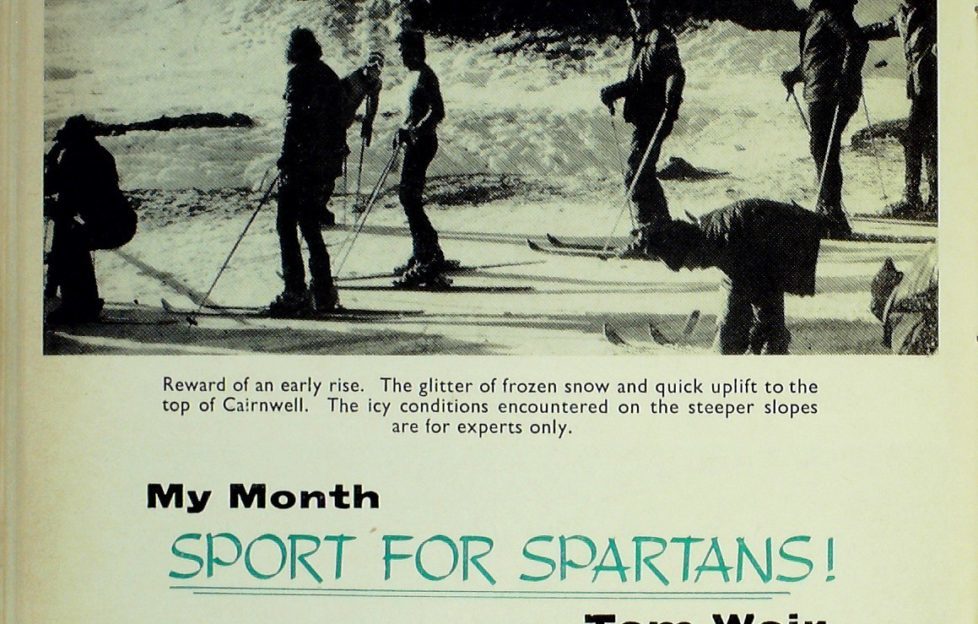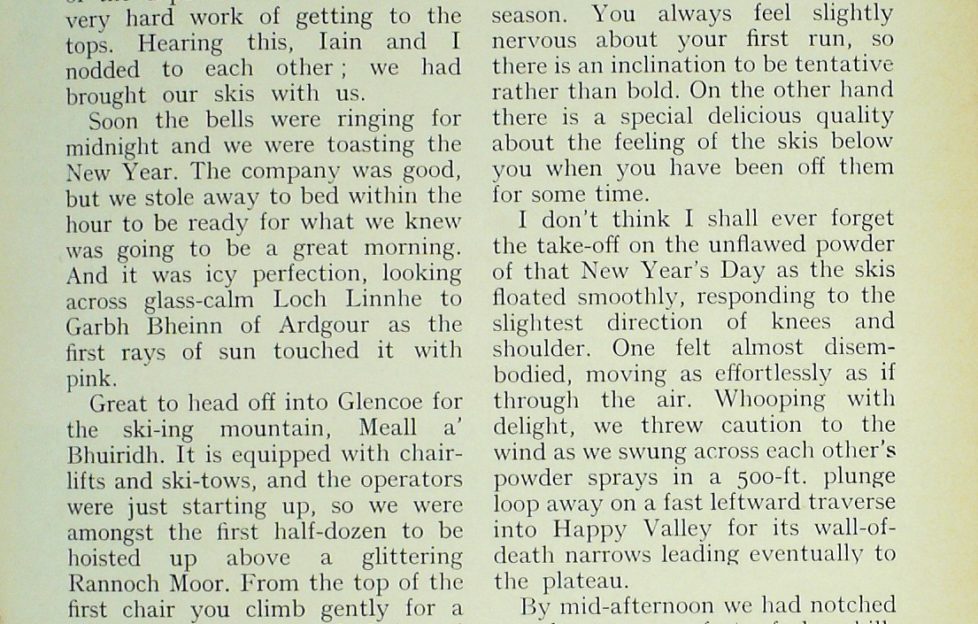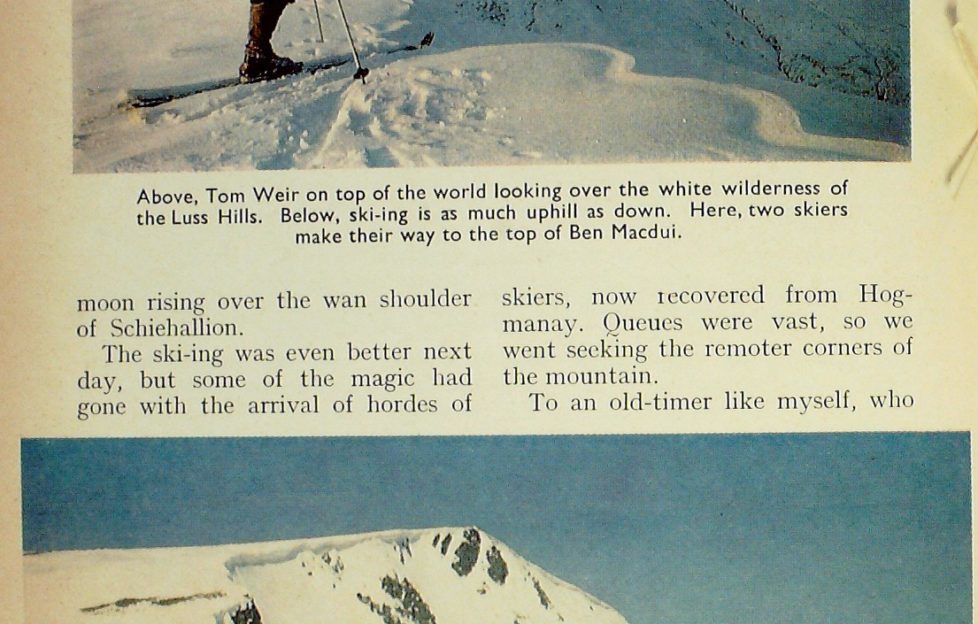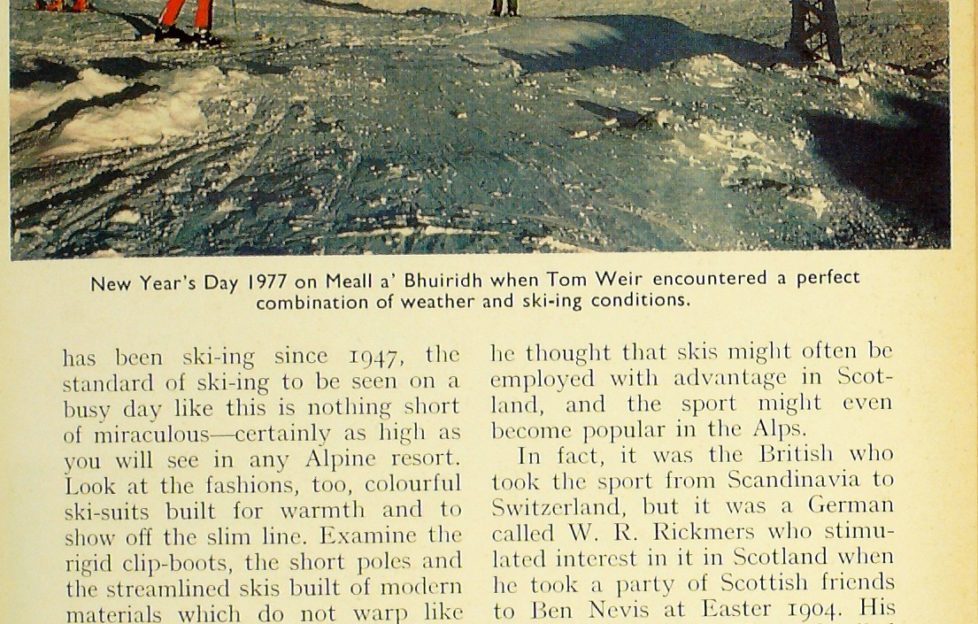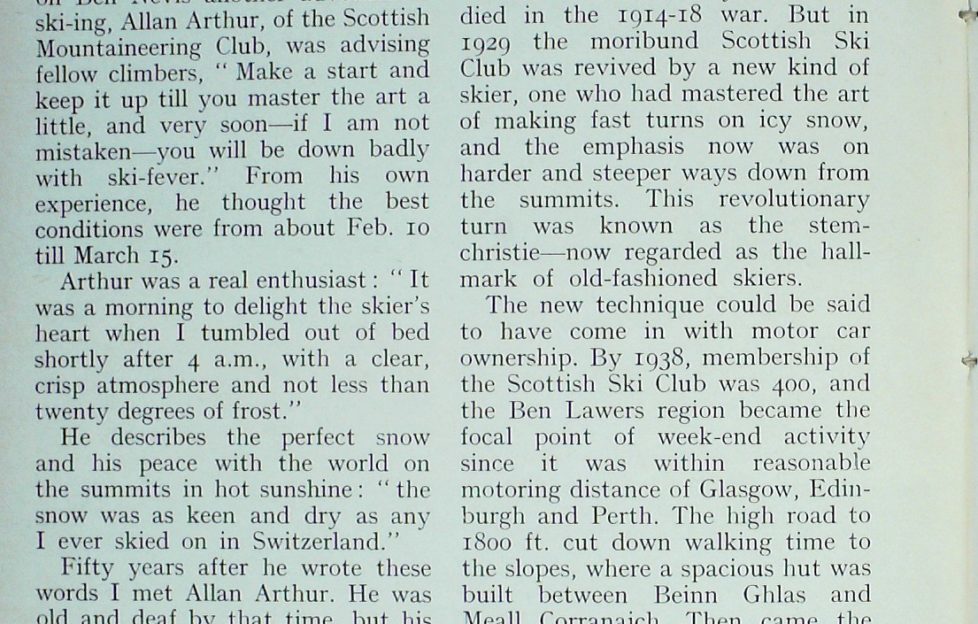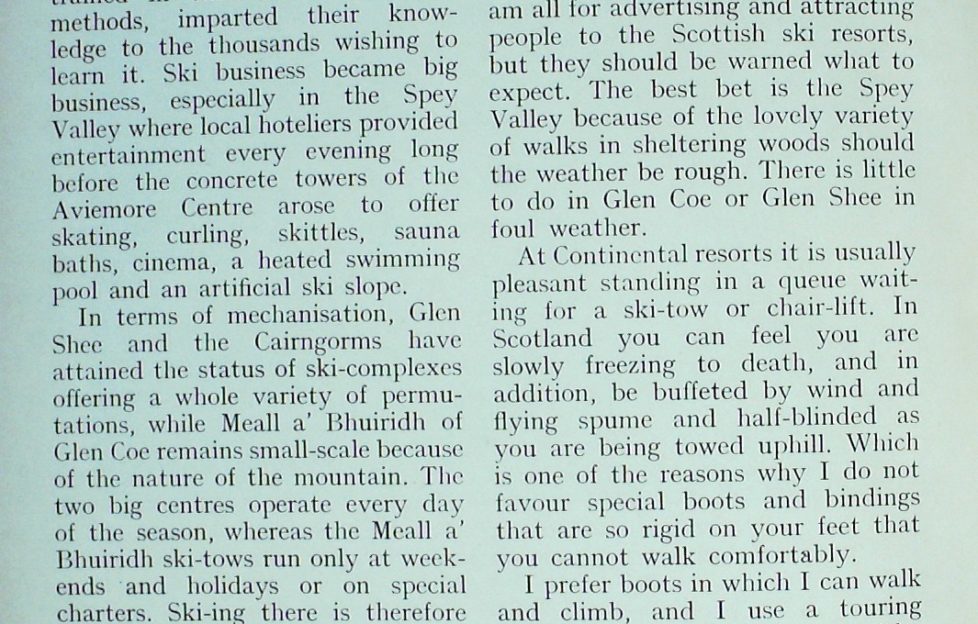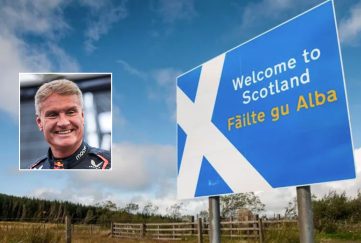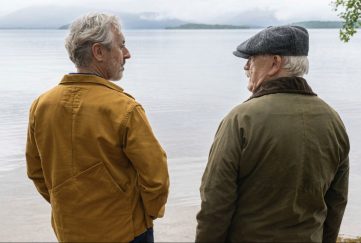Tom Weir | Sport For Spartans
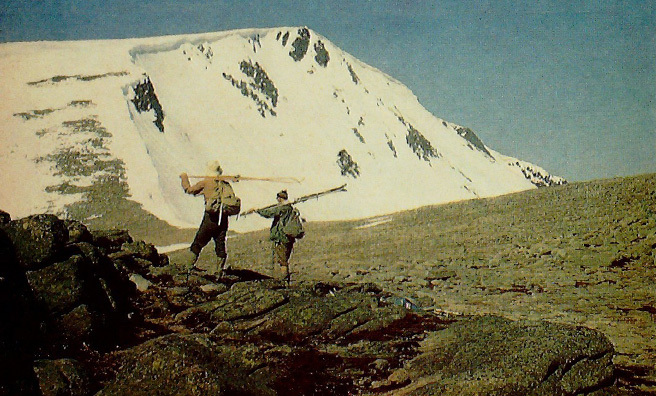
After a glorious year of skiing in 1977, Tom Weir looks back at the rise of Scottish skiing, and why it’s a completely different beast to continental skiing…
The year has ended and for most folk the memory of a fine summer lingers on. And how marvellous it was after a tardy spring! Of course, people grew very tired of that long, hard winter. But not if you were a skier, for seldom have weather and snow conditions combined to produce such a run of perfect week-ends. Friends of mine notched up over a hundred ski-ing days with hardly a wetting.
And in May an old friend celebrated his 83rd birthday by ski-ing from Cairngorm to Ben Macdui. In the blaze of the mid-summer sun there was still good ski-ing being enjoyed up there.
I, too, shared in the bonanza, and the ski-ing days that shine brightest as I look back were the first two of 1977. Even the drive up to Glencoe on Hogmanay night was memorable, with snow crunching beneath the car tyres and the icy peaks hard and brilliant under a silver moon.
My destination was the hotel where the Scottish Mountaineering Club meet was being held, and it was great to see so many old friends. Sergeant Whillans of the Glencoe rescue team was there, face shining with health, having just climbed the Pap of Glencoe to enjoy the moonlight glitter on snow-shrouded peaks and sea. Other friends who had been climbing that day spoke of the depth of snow which made very hard work of getting to the tops. Hearing this, Iain and I nodded to each other; we had brought our skis with us.
“like diamonds in the sunlight…”
Soon the bells were ringing for midnight and we were toasting the New Year. The company was good, but we stole away to bed within the hour to be ready for what we knew was going to be a great morning. And it was icy perfection, looking across glass-calm Loch Linnhe to Garbh Bheinn of Ardgour as the first rays of sun touched it with pink.
Great to head off into Glencoe for the ski-ing mountain, Meall a’ Bhuiridh. It is equipped with chair- lifts and ski-tows, and the operators were just starting up, so we were amongst the first half-dozen to be hoisted up above a glittering Rannoch Moor.
From the top of the first chair you climb gently for a mile to reach the second chair and ski-tows, which brings you into shadow on the north face. Soon we were on the drag-lift heading into the sunshine of the summit ridge where barnacles of ice festooning the crags sparked like diamonds in the sunlight.
We climbed up the edge of the pendulous snow cornice overhanging Corrie Ba to enjoy in isolation the incredible vision of Arctic Scotland in the low light of the January sun.
What a welter of peaks! In front of us Ben Dorain, Ben More, Lui, Starav, Cruachan and the hills of Mull above a soft gleam of Atlantic; behind us Nevis and the Mamores ; eastward Ben Alder. Nor was it just a white world. It was full of texture, colour and moulded by shadow.
Throwing caution to the wind
Now I braced myself for the big test. Could I handle my skis as of yore? Meall a’ Bhuiridh is rockier, steeper and more daunting than the smoother Cairngorms of Glen Shee. Two skiers were killed on it last season. You always feel slightly nervous about your first run, so there is an inclination to be tentative rather than bold. On the other hand there is a special, delicious quality about the feeling of the skis below you when you have been off them for some time.
I don’t think I shall ever forget the take-off on the unflawed powder of that New Year’s Day as the skis floated smoothly, responding to the slightest direction of knees and shoulder. One felt almost disembodied, moving as effortlessly as if through the air. Whooping with delight, we threw caution to the wind as we swung across each other’s powder sprays in a 500-ft. plunge loop away on a fast leftward traverse into Happy Valley for its wall-of-death narrows leading eventually to the plateau.
By mid-afternoon we had notched up about 15,000 feet of downhill-running, yet not a muscle felt tired. When the lifts closed we climbed to the summit and in a bitter wind watched the red ball of the sun go down, casting a crimson light in Alpenglow on every peak. It was magical, especially when snow spume blown vertically upwards from the corrie showered round us like sparks from a fire. We took the descent from the 3000-ft. top with only one stop—to watch the full moon rising over the wan shoulder of Schiehallion.
The ski-ing was even better next day, but some of the magic had gone with the arrival of hordes of skiers, now recovered from Hogmanay. Queues were vast, so we went seeking the remoter corners of the mountain.
The history of skiing in Scotland
To an old-timer like myself, who has been ski-ing since 1947, the standard of ski-ing to be seen on a busy day like this is nothing short of miraculous—certainly as high as you will see in any Alpine resort. Look at the fashions, too, colourful ski-suits built for warmth and to show off the slim line. Examine the rigid clip-boots, the short poles and the streamlined skis built of modern materials which do not warp like wood. Talk to the skiers and you will find that most are working class, as are so many climbers nowadays.
I have been exercising myself tracing the evolution of Scottish ski-ing, which begins with W. W. Naismith and a friend ski-ing to the Meikle Bin on the Campsies in 1892. Naismith has been called the father of the Scottish Mountaineering Club, and he observed that they moved faster and with less effort than on foot, also “… that a very slight gradient was sufficient to get up a tremendous speed.” Summing up, he thought that skis might often be employed with advantage in Scotland, and the sport might even become popular in the Alps.
In fact, it was the British who took the sport from Scandinavia to Switzerland, but it was a German called W. R. Rickmers who stimulated interest in it in Scotland when lie took a party of Scottish friends to Ben Nevis at Easter 1904. His article in the S.M.C. Journal called “Aquatic Sport on Ben Nevis,” describes eight days of rain teaching a party to ski on the summit slopes of our biggest Ben.
Rickmers thought nothing of the big carry-up there because the 2000-ft. ski-ing slope from summit to lochan was so good. Rickmers was teaching a technique that had no real future in Scotland. The short, grooveless skis steered by a single pole were all right for soft spring snow or deep powder, but no use on the icy conditions which are so common in Scotland.
He certainly liked what he saw on Ben Nevis, saying that such perfect slopes of 2000 ft. length in such line conditions for ski-ing are rarely met with. But the shrewdest observation he made was that in a climate like ours the best ski-ing possibilities would be in spring rather than winter.
Four years after these adventures on Ben Nevis another advocate of ski-ing, Allan Arthur, of the Scottish Mountaineering Club, was advising fellow climbers, “Make a start and keep it up till you master the art a little, and very soon—if I am not mistaken—you will be down badly with ski-fever.” From his own experience, he thought the best conditions were from about Feb. 10 till March 15.
Arthur was a real enthusiast: “It was a morning to delight the skier’s heart when I tumbled out of bed shortly after 4 a.m., with a clear, crisp atmosphere and not less than twenty degrees of frost.”
He describes the perfect snow and his peace with the world on the summits in hot sunshine: “the snow was as keen and dry as any I ever skied on in Switzerland.”
A life-long obsession
Fifty years after he wrote these words I met Allan Arthur. He was old and deaf by that time, but his interest in ski-ing was undiminished and he was a regular attender at club lectures. I found myself thinking of him last March as I skied up the north ridge of Ben Vane and looked across to the adjacent top of a flawless white Ben Ledi.
Following the line down from the summit, I fancied I saw him with three other members of the Scottish Ski Club, swinging down in wide turns for a full 1500 ft., then shouldering their skis to climb to the summit again for another run down.
Of that particular occasion, he wrote, “We one and all agreed that even in Switzerland such an expedition, on such a day, could not well be beaten.”
I echoed these sentiments as I swung down from the summit after half an hour of glorious views from the summit stretching from the Forth to the hills of Arran.
Scottish ski-ing, like Scottish mountaineering, received a big setback because so many keen men died in the 1914-18 war. But in 1929 the moribund Scottish Ski Club was revived by a new kind of skier, one who had mastered the art of making fast turns on icy snow, and the emphasis now was on harder and steeper ways down from the summits. This revolutionary turn was known as the stem- christie—now regarded as the hall-mark of old-fashioned skiers.
The new technique could be said to have come in with motor car ownership. By 1938, membership of the Scottish Ski Club was 400, and the Ben Lawers region became the focal point of week-end activity since it was within reasonable motoring distance of Glasgow, Edinburgh and Perth. The high road to 1800 ft. cut down walking time to the slopes, where a spacious hut was built between Beinn Ghlas and Meall Corranaich. Then came the installation of two small ski-tows above the hut in January 1952, precursors of the first Continental-type ski-tow in Scotland.
A new wave of skiers
For this most ambitious development on any Scottish hill the Scottish Ski Club wisely chose Meall a’ Bhuiridh. It is in a bad weather area, but possesses north-facing, snow — holding corries — the major deficiency of the Lawers range. Nor were Dundee skiers idle at this time. They had put up small ski-tows in Glen Shee, on Ben Gulabin above the Spittal, and on Cam an Tuirc.
It didn’t take long for me to see that touring men like myself, who had thought of themselves as competent skiers, were being left very far behind by comparative beginners applying themselves to a new style of dynamic ski-ing based on the parallel swing.
Chair-lifts on Meall a Bhuindh, in Glen Shee and a big mechanisation programme above Loch Morlich in the Cairngorms, speeded the technical advance as ski-teachers, trained in the latest Continental methods, imparted their knowledge to the thousands wishing to learn it. Ski business became big business, especially in the Spey Valley where local hoteliers provided entertainment every evening long before the concrete towers of the Aviemore Centre arose to offer skating, curling, skittles, sauna baths, cinema, a heated swimming pool and an artificial ski slope.
In terms of mechanisation, Glen Slice and the Cairngorms have attained the status of ski-complexes offering a whole variety of permutations, while Meall a’ Bhuiridh of Glen Coc remains small-scale because of the nature of the mountain. The two big centres operate every day of the season, whereas the Meall a’ Bhuiridh ski-tows run only at week¬ends and holidays or on special charters. Ski-ing there is therefore more expensive because of the small financial return for a big outlay.
When it comes to comparing the relative merits of Scotland or the Continent for ski-ing there is no doubt at all that you stand a better chance of getting value for your money in terms of sunshine and ample snow than in Scotland. What we offer is sport for spartans. True, last winter was marvellous, and so was 1963 and 1952, but let’s face it, in the name of ski-ing we endure whiteout, wind, rain and sunless grey days that would be intolerable to Continentals. We cannot even guarantee snow until the February storms fill the gullies.
Rickmers was right when he nominated the spring as the season for Scottish ski-ing. Yet it is also true that it can be winter any day of the year on the Scottish hills, and that January, February and March usually provide excellent ski conditions somewhere, sometime. I am all for advertising and attracting people to the Scottish ski resorts, but they should be warned what to expect. The best bet is the Spey Valley because of the lovely variety of walks in sheltering woods should the weather be rough. There is little to do in Glen Coe or Glen Shee in foul weather.
At Continental resorts it is usually pleasant standing in a queue wait¬ing for a ski-tow or chair-lift. In Scotland you can feel you arc slowly freezing to death, and in addition, be buffeted by wind and flying spume, and half-blinded as you are being towed uphill. Which is one of the reasons why I do not favour special boots and bindings that are so rigid on your feet that you cannot walk comfortably.
I prefer boots in which I can walk and climb, and I use a touring binding on my skis which enables me to lift the heel and ski in the good old cross-country Scandinavian way.
Allan Arthur was right about ski-fever being an incurable disease. And so was the late Harry Mac Robert when he advised climbers to take up the sport, “even if only for something less strenuous than rock-climbing to fall back on in old age.”
Read more from Tom Weir’s archives next Friday!
More…
Read more from Tom!
We have an extensive archives of Tom Weir’s great columns for The Scots Magazine, and we’re slowly getting them published digitally for new generations to enjoy.
To see the columns we have online so far, click here for Tom’s online archives.


